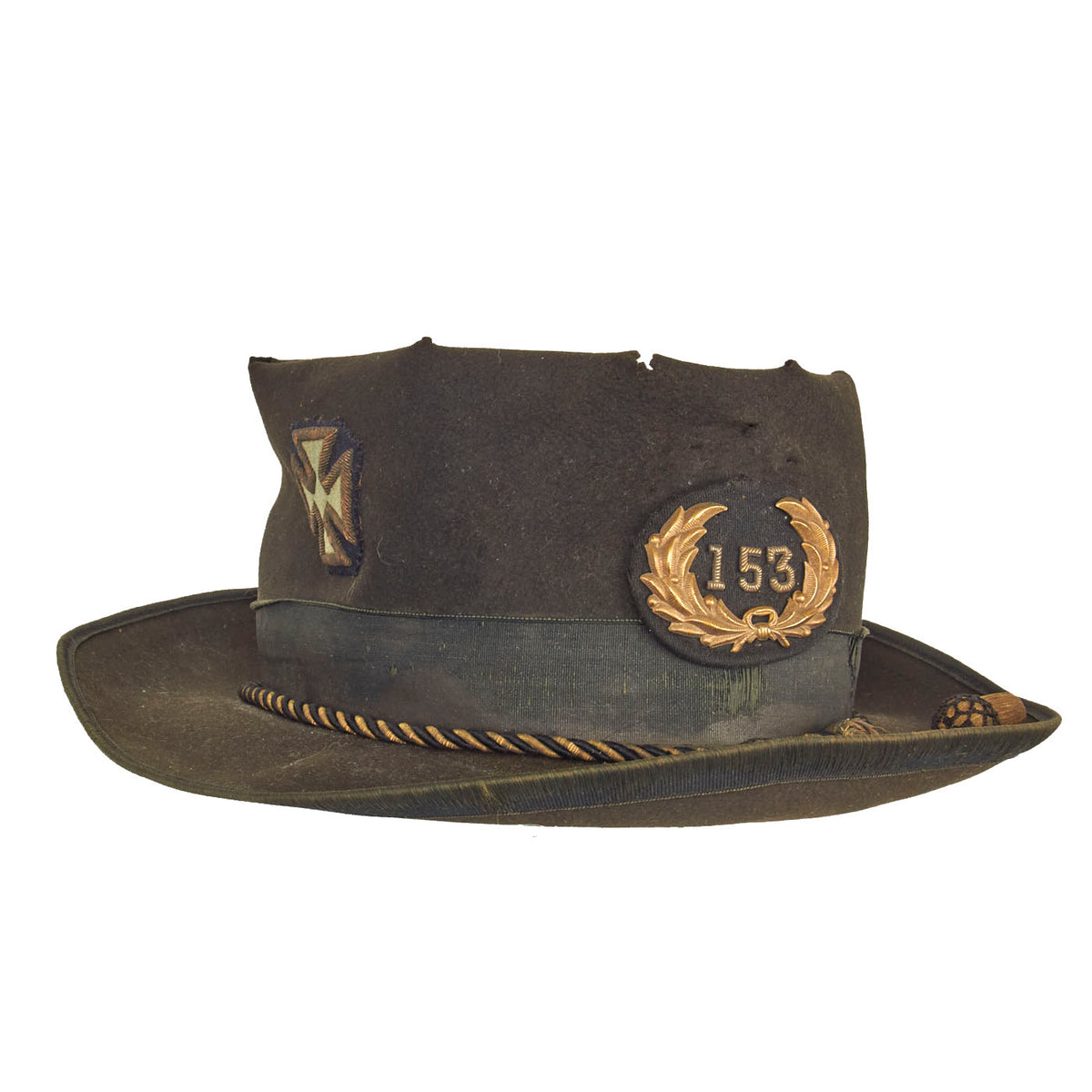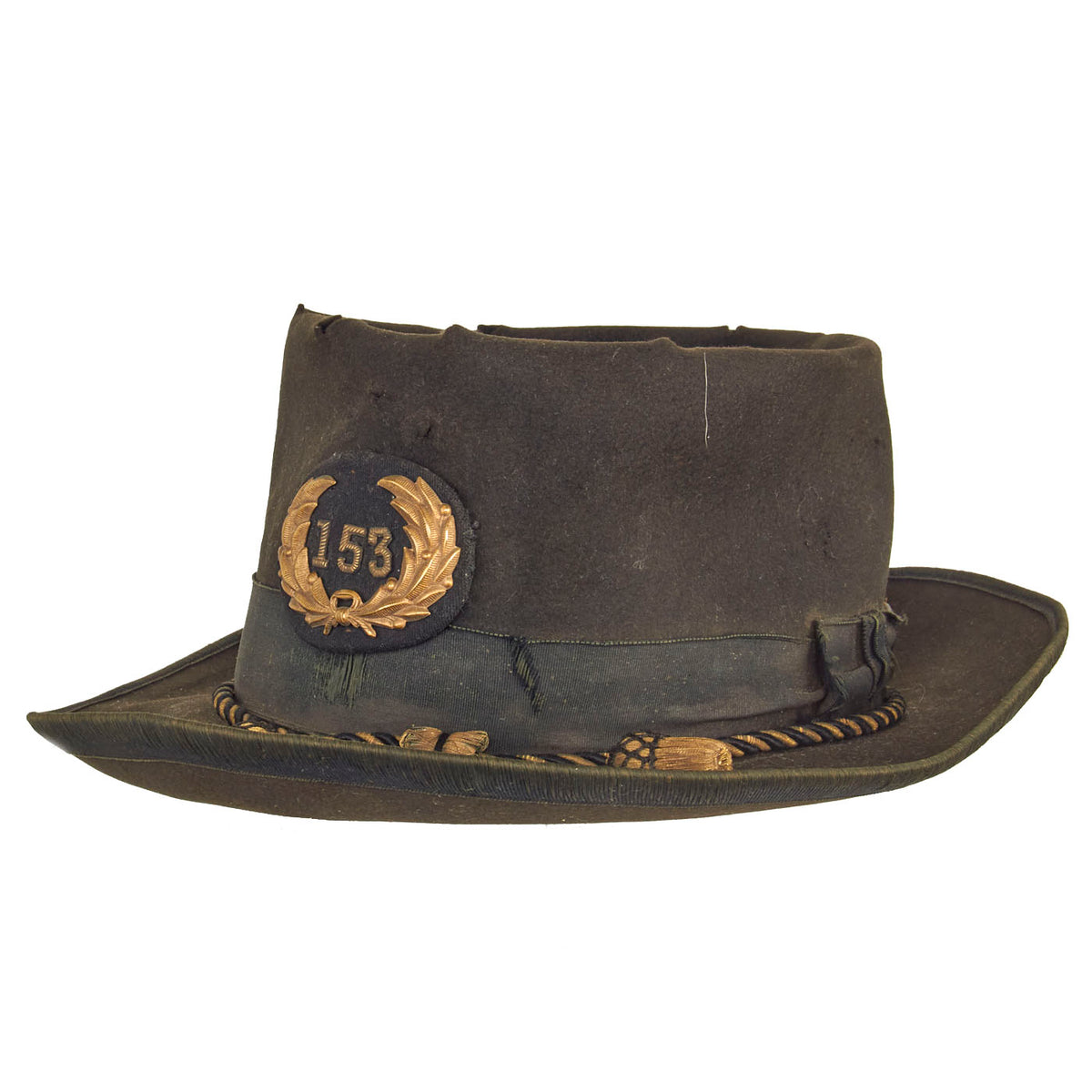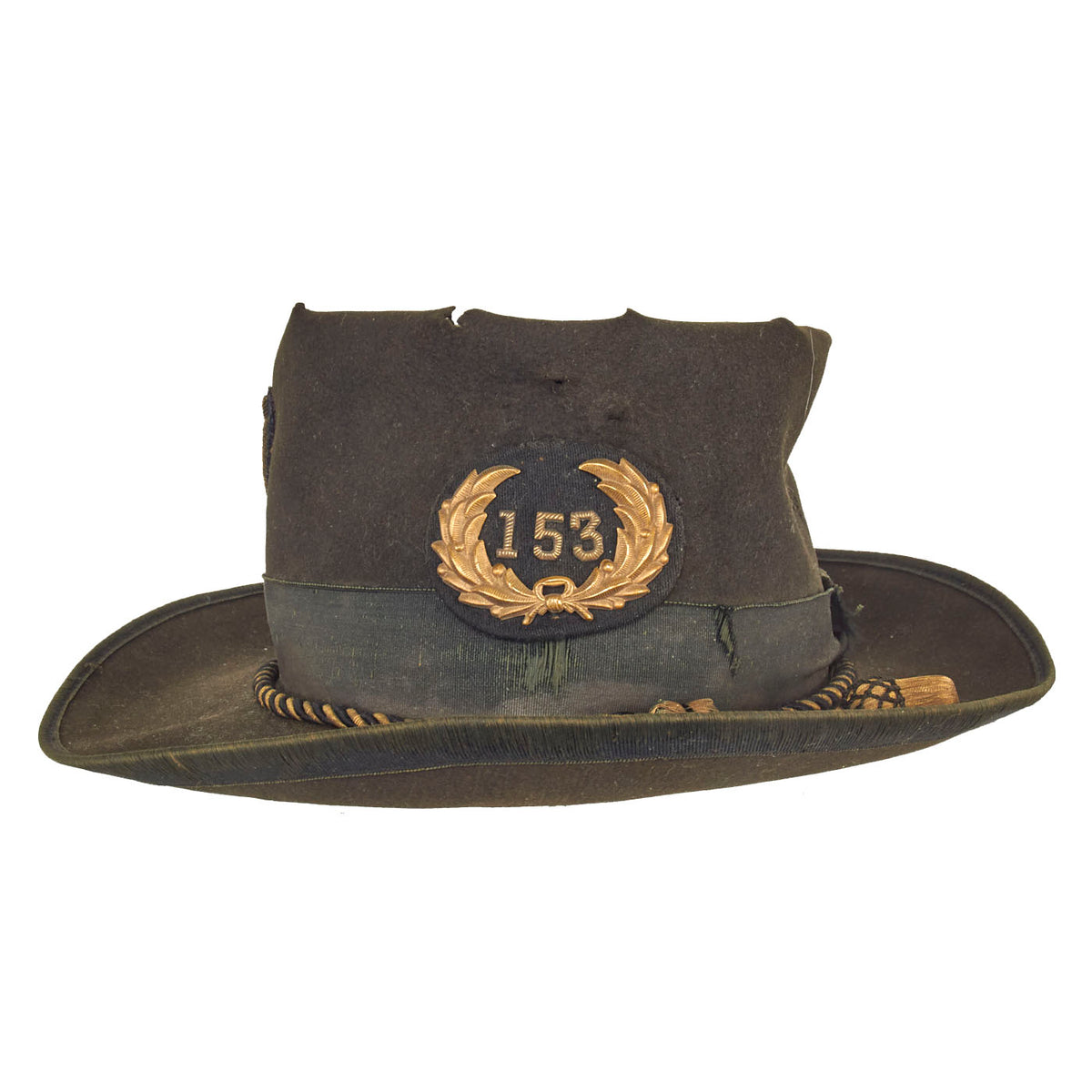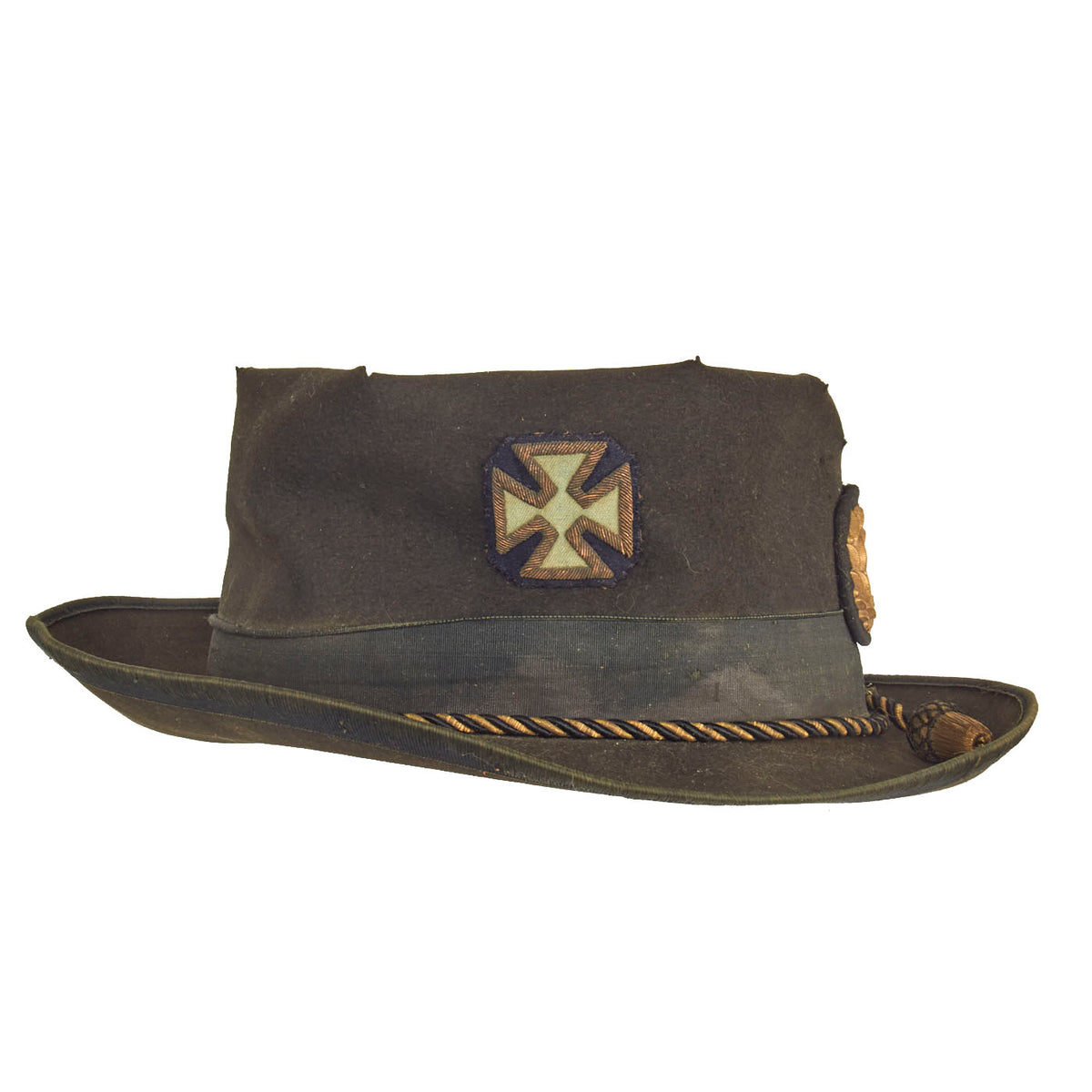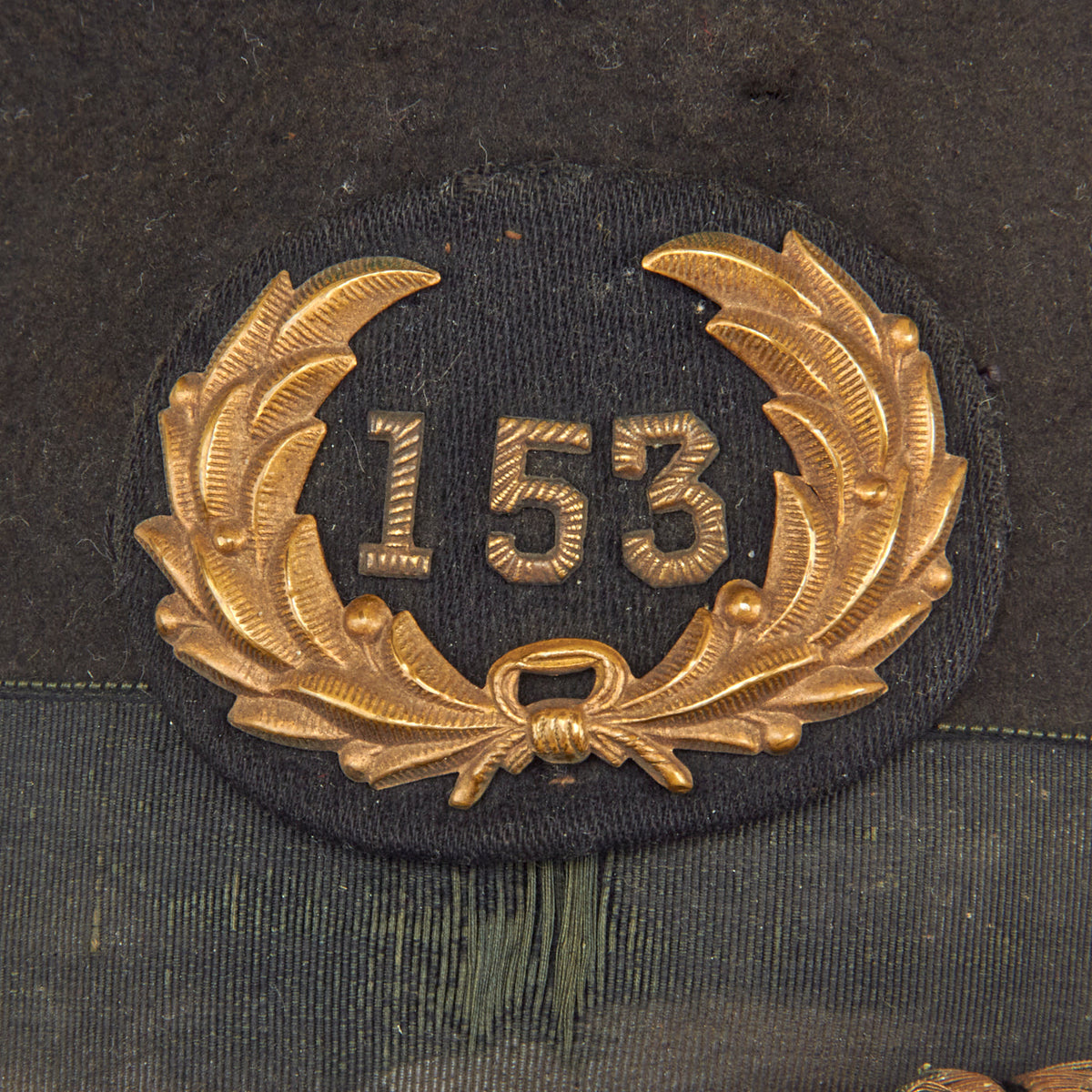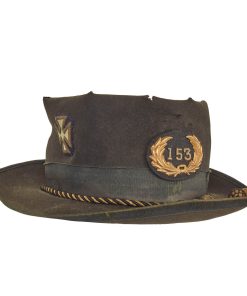Original Civil War Union Officer’s Slouch Hat with 19th Corps Badge and Officer’s Hat Cord with G.A.R. Veteran’s Insignia Wreath Original Items
$ 1.095,00 $ 273,75
Original Item: One-Of-A-Kind. This is a stunning example of a Civil War Union Officer’s Hat worn by a member of the 19th Corps during the war. The Hat is a typical 1860’s produced hat, made of black fur felt with a 2 ½” wide brim. The hat still retains its original black Moroccan leather sweatband which is securely affixed to the interior of the hat. The original silk hat band, and silk visor edging is intact as well. It should be noted that the brim edging is completely originally hand sewn, a clear indicator that this hat is of Civil War era manufacture, as sewing machines were quite rare at that time!
The hat features an original Civil War officer’s bullion hat cord, which appears to have been placed on the hat for a very, very, long time. The hat shows signs of wear from honest campaign use during the war. Hand-sewn on the right side of the hat is a beautiful example of a 12th Corps Badge, which is made from wool and gold bullion thread. The wreathed numbered insignia on the front indicates that the original owner of this hat was a member of G.A.R Post #153 which was located in Carnegie, Pennsylvania (There is a facebook group and a website dedicated to this G.A.R. Post with some fascinating information!). Grand Army of the Republic was a veteran’s organization founded for Civil War veteran’s. Veteran’s would wear their old uniforms for meeting and other special occasions. In the case of this hat, the veteran officer simply tacked an insignia to the front which represented what GAR post he belonged to. Quite a fascinating piece!
The 19th Corps During the Civil War:
XIX Corps was a corps of the Union Army during the American Civil War. It spent most of its service in Louisiana and the Gulf, though several units fought in Virginia’s Shenandoah Valley.
XIX Corps was created on December 14, 1862, and assigned to Maj. Gen. Nathaniel P. Banks, the commander of the Department of the Gulf. The corps comprised all Union troops then occupying Louisiana and east Texas. It originally consisted of four divisions, numbering 36,000 men.
In April 1863, the corps was involved in the actions at Fort Bisland and Irish Bend. It operated the Siege of Port Hudson from April 27–July 9, 1863, the fall of which, along with that of Vicksburg, Mississippi, closed off the Mississippi River to Confederate shipping. XIX Corps also gained measure of distinction for being the first Federal unit to use a large number of colored troops in action, particularly against Port Hudson, with Banks giving them due credit for their valiant contributions to the siege.
In spring of 1864, the corps took part in Banks’ disastrous Red River Campaign, under the command of William B. Franklin, who was wounded at Mansfield. After its conspicuous role in the failure, two divisions under William H. Emory were sent to Virginia to join Phillip Sheridan’s operations in the Shenandoah Valley against Jubal Early (see Valley Campaigns of 1864). These troops took part in all of the major engagements of Sheridan’s campaign, most notably at Opequon, where they lost some 2,000 men killed or wounded (mostly in Cuvier Grover’s division).
After this, the corps was sent to Savannah, Georgia, where it remained until the end of the war. The XIX Corps was officially disbanded on March 26, 1865, but the corps took part in the Grand Review in Washington, and some of its units remained in Savannah and Louisiana until 1866.
This is an awesome piece, which displays handsomely! Ready for display!
Corps Badges During the Civil War:
Corps badges in the American Civil War were originally worn by soldiers of the Union Army on the top of their army forage cap (kepi), left side of the hat, or over their left breast. The idea is attributed to Maj. Gen. Philip Kearny, who ordered the men in his division to sew a two-inch square of red cloth on their hats to avoid confusion on the battlefield. This idea was adopted by Maj. Gen. Joseph Hooker after he assumed command of the Army of the Potomac, so any soldier could be identified at a distance.
Maj. Gen. Daniel Butterfield, Hooker’s chief of staff, was assigned the task of designing a distinctive shape for each corps badge. Butterfield also designated that each division in the corps should have a variation of the corps badge in a different color. Division badges were colored as follows:
Red — First division of corps
White — Second division of corps
Blue — Third division of corps
These were used in the United States’ Army of the Potomac. For the most part, these rules were adopted by other Union Armies, however it was not universal. For example, the XIII Corps never adopted a badge, and the XIX Corps had the first division wear a red badge, the second division wear a blue badge, and the third division wear white.
For Army corps that had more than three divisions, the standardization was lost:
Green — Fourth division of VI, IX, and XX Corps
Yellow — Fourth division of XV Corps (reportedly Orange was also used for a 5th Division Badge)
Multicolor — Headquarters or artillery elements (certain corps)
The badges for enlisted men were cut from colored cloth, while officer’s badges were privately made and of a higher quality. Metallic badges were often made by jewelers and were personalized for the user. The badges eventually became part of the Army regulations and a great source of regimental pride
Fast Shipping with Professional Packaging
Thanks to our longstanding association with UPS FedEx DHL, and other major international carriers, we are able to provide a range of shipping options. Our warehouse staff is expertly trained and will wrap your products according to our exact and precise specifications. Prior to shipping, your goods will be thoroughly examined and securely secured. We ship to thousands clients each day across multiple countries. This shows how we're dedicated to be the largest retailer on the internet. Warehouses and distribution centres can be located throughout Europe as well as the USA.
Note: Orders with more than one item will be assigned a processing date depending on the item.
Before shipping before shipping, we'll conduct a thorough inspection of the items you have ordered. Today, the majority of orders will be delivered within 48 hours. The delivery time will be between 3-7 days.
Returns
The stock is dynamic and we cannot completely manage it because multiple stakeholders are involved, including our factory and warehouse. So the actual stock may alter at any time. It's possible that you may not receive your order once the order has been made.
Our policy is valid for a period of 30 days. If you don't receive the product within 30 days, we are not able to issue a refund or an exchange.
You can only return an item if it is unused and in the same state as the day you received it. You must have the item in its original packaging.
Related products
Uncategorized
Uncategorized
Armoured Fighting Vehicles of the World: AFVs of World War One (Hardcover Book) New Made Items
Uncategorized
Uncategorized
Uncategorized
Uncategorized
Armored Burgonet Helmet & Polearm from Scottish Castle Leith Hall Circa 1700 Original Items
Uncategorized
Uncategorized
Uncategorized
Australian WWII Owen MK1 Machine Carbine SMG Custom Fabricated Replica with Sling Original Items
Uncategorized
Uncategorized
Uncategorized
Uncategorized
Uncategorized
Uncategorized
Uncategorized
Uncategorized
Uncategorized
Angolan Rebel 1970s era 60mm Inert Display Mortar from Angolan Civil War Original Items
Uncategorized
Uncategorized
Uncategorized
Uncategorized
Band of Brothers ORIGINAL GERMAN WWII Le. F.H. 18 10.5cm ARTILLERY PIECE Original Items
